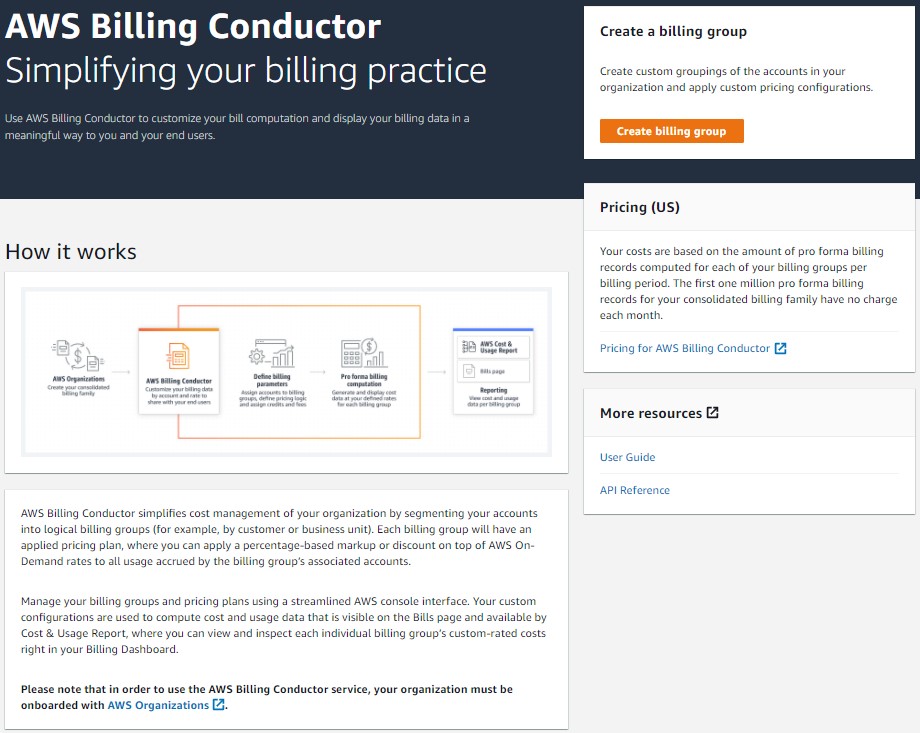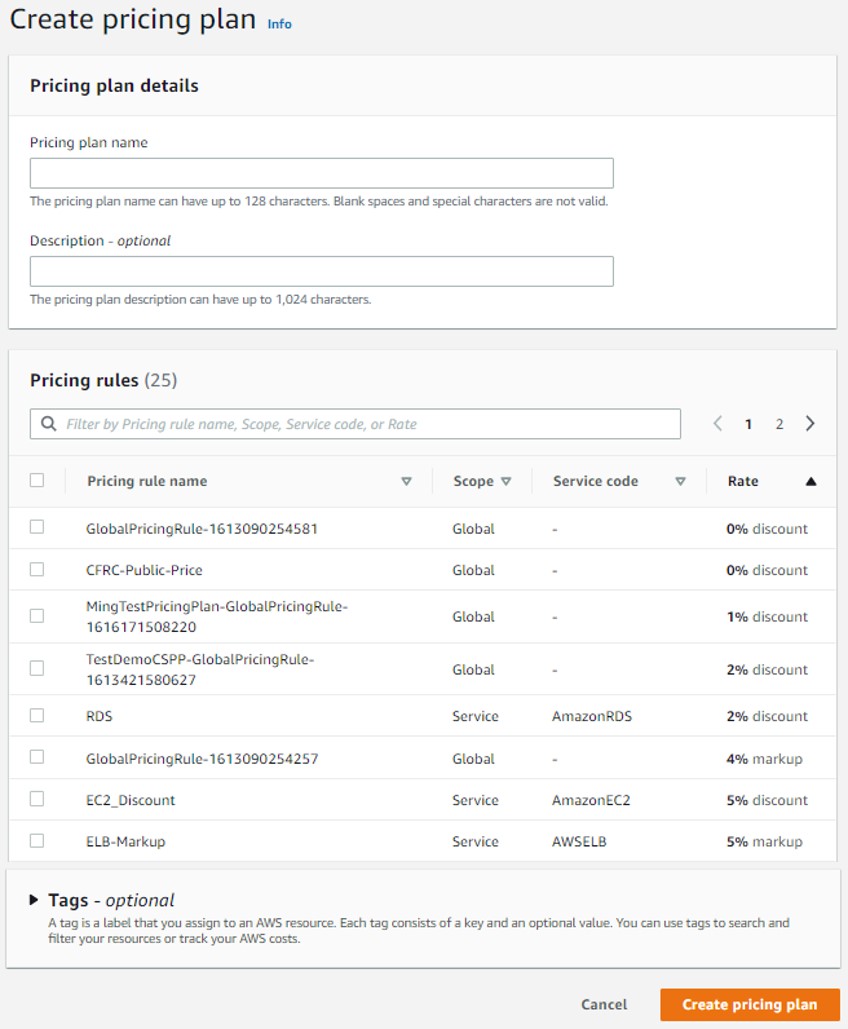AWS Cloud Financial Management
Getting Started with AWS Billing Conductor
We are happy to announce that another key capability was recently added to AWS Cloud Financial Management solution. Starting today, you can access AWS Billing Conductor (hereinafter referred to as “ABC”), a new service that enables AWS customers and solution provider workflows by customizing billing data and reporting in a way that aligns with your unique business logic.
Background
Thousands of AWS customers use Consolidated Billing features each month to simplify their monthly billing and invoicing workflows. Consolidated Billing allows you to apply your Reserved Instances (RI), Savings Plans savings, and credits across all the accounts in your consolidated billing family––all in an effort to reduce your AWS costs. Read “Understanding consolidated billing” user guide for details.
While Consolidating Billing is designed to maximize your savings opportunities, the application of the savings from your RIs, Savings Plans, and credit benefits may not always match your desired distribution methods across different lines of business or end customers in the case for reseller partners. As often your internal billing hierarchy cannot be easily applied to your AWS consolidated bill, many of you have developed unique chargeback workflows to allocated costs to the right end customer, which could require substantial investment of resources to set up and maintain.
These workflows often include dedicated Financial Operations (FinOps) teams who segment and post-process the Cost and Usage Report (CUR) by end customer. Once FinOps segments the CUR, they replace any service-specific discounts, RI and Savings Plans discounts, and credits with the rates and terms agreed to with the end customer (e.g., public on demand rates). Once the right rates are applied, FinOps recalculates the bill for each end customer before sharing the revised billing data and reports.
With the launch of the AWS Billing Conductor (ABC), it’s easier than ever for FinOps teams to configure, generate, and share the right rates to the end users– irrespective of the rates the customer has negotiated with AWS. With ABC, customers can group end user accounts, apply custom pricing rules, add custom line items (e.g. shared support costs and other internal overhead costs), and generate CURs for each of end customers within 24 hours of setting up their ABC configuration.
Getting Started with AWS Billing Conductor (ABC)
Getting started with AWS Billing Conductor (ABC) is simple. While this blog will focus on the console workflow, you can also leverage the ABC APIs or AWS CloudFormation templates to automate your ABC configuration.
Prerequisites
For this walkthrough, you should have the following prerequisites:
- Access to the Payer / Management Account
- AWS Identity and Access Management (IAM) user with permissions of
- billingconductor
- organizations:ListAccounts
- pricing:DescribeServices.privileges
I. Create a billing group
You can navigate to the AWS Billing Conductor under the AWS Cost Management section of the Management console or by searching for “AWS Billing Conductor”.
In the AWS Billing Conductor landing page, click “Create billing group”.

Billing groups allow you to have an aggregated view for a set of accounts at specified billing rates. The primary account that you selected will have cross account visibility within the billing group. Note that you must select your primary account when you create your billing group, since you can’t change your primary account after the billing group is created. To assign a new primary account, you need to delete this billing group and regroup your accounts. Currently, a payer account can be included within a billing group, but cannot be assigned the role of the primary account. If you move accounts across billing groups in the middle of a month, it will initiate a re-computation of billing groups impacted back to the start of this very billing period, not previous billing periods. View the user guide “create billing group” for more details about this step.

II. Customize your pricing configuration
While we created a default pricing plan with no pricing rules associated during the billing group creation process, we want to walk you through the pricing configuration resources, pricing rules and pricing plans.
Pricing rules allow you to apply global (applying to all services) and service specific rules to the resources running in a given account. Any adjustments, markup or discount, is calculated based on the public on-demand rate. You can also use 0%, for discount or markup options to default to the public on-demand rate for a given service. A pricing rule, once created, can be used across multiple billing groups.

Pricing plans are simply a container for your pricing rules. This approach allows you to update a pricing rule (e.g., change my EC2 discount from 3 to 5 %) that spans across multiple pricing plans with a single pricing rule change. For pricing plans with a mix of global and service specific pricing rules, the most granular rule is run first, before the global rule is applied to the remaining services (no rate stacking). Only one pricing plan can inform the billing group for a given billing period.

III. Evaluate margins
The margin analysis reports are available as a bar chart and a table view in ABC console, where you can view your margins for an individual billing group or a set of billing groups.

IV. Pro forma Cost & Usage Report and Billing View
The primary account in the billing group can generate a pro forma Cost & Usage Report (CUR) for the group, while other non-primary accounts in the billing group can only generate a pro forma for their own account. A summary view of pro forma billing data at the billing group level is also available on the AWS Bills page. Read the user guide “Configuring Cost and Usage Reports per billing group” and learn how you can create the pro forma CUR report for the billing group you created. The pro forma AWS CUR has the same file format, granularity, and columns as the standard AWS CUR. You’ll notice a slight delay between your standard CUR and your pro forma CUR. This is expected as they are separate workflows. Monir data volume differences can be attributed to this time difference throughout the month, but the usage across both reports will match once the billing period is closed. Your pro forma CUR file, once created, can then be queried directly using Amazon Athena or integrated into your existing analytics and reporting tools such as Amazon QuickSight and our AWS Well Architected Cloud Intelligence Dashboards.
24 hours after you create billing groups and assign them with the pricing plans and rules, you can view the pro forma billing in your AWS billing page. Read the user guide “Viewing your billing group details” and learn the things you need to look out for in this pro forma billing view.
Conclusion
We appreciate many of you who provided valuable feedback to us as we develop this new capability. You can learn more about AWS Billing Conductor’s features and pricings by visiting the product webpage, and get started with the user guide and API reference.
If you have questions or need help onboarding, don’t hesitate to contact your available support channels so we can respond directly to your request.